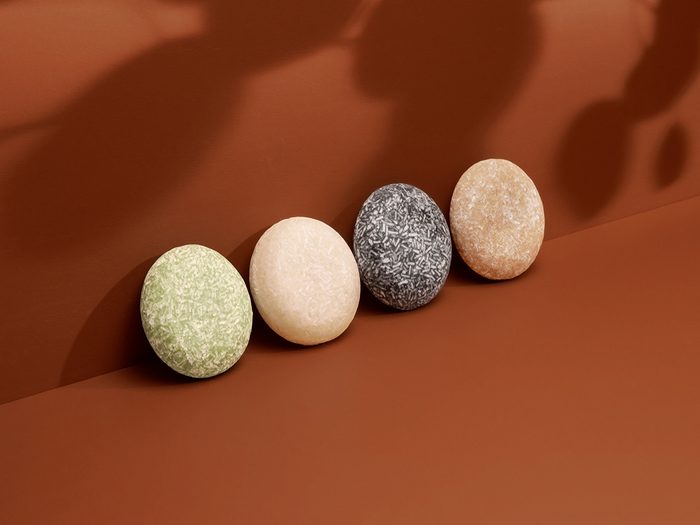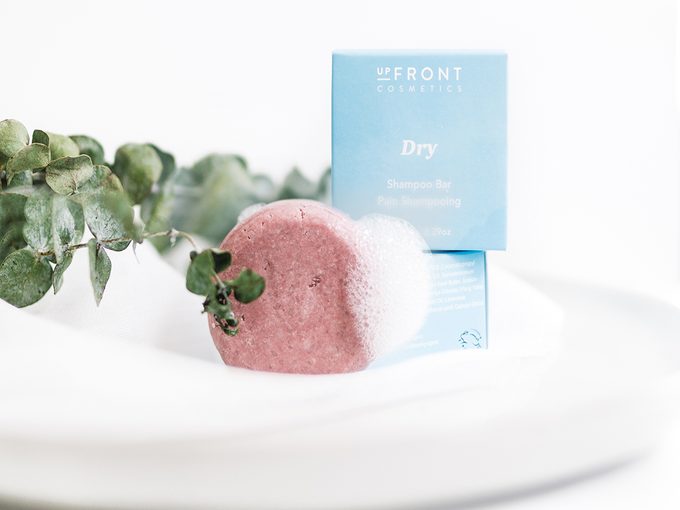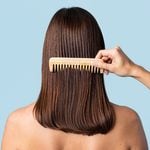Do Shampoo Bars Work?

These low-waste shampoo alternatives are popping up everywhere, but how do they differ from traditional liquid shampoo?
If you, like me, are concerned about plastic pollution, it’s time to learn about shampoo bars. It’s estimated that Canadians throw away 3 million tonnes of plastic waste annually, and only 9 percent of it is ever recycled—leaving the majority of it in landfills and waterways. Swapping out traditional shampoo and soap bottles for packaging-free bars is an easy way to cut down on plastic waste.
Though the environmental benefits are obvious (who doesn’t want to save the turtles?!), the health and beauty benefits are a bit more opaque. Would switching from my tried-and-true liquid shampoo still do the trick? Are bars more difficult to use?
I tried two different brands, Toronto-based Good Juju and Fredericton-based UpFront Cosmetics, and spoke to the founders to better understand what to expect.
(Related: 38 Secrets Your Hair Stylist Won’t Tell You)
What are shampoo bars?
Basically, shampoo bars are a more concentrated, solid form of what you traditionally find in a bottle of shampoo. “We take the water out, remove any other liquid ingredients and leave the really good stuff that you’re rubbing directly into your hair,” explains Lisa Karandat, one of the co-founders of Good Juju.
There are a few different kinds of bars: soap-based, detergent-based, and those that are pH-balanced. Each has its own benefits. Soap-based and detergent-based bars tend to have a higher pH (usually hovering around 9 or 10), which is great for adding volume, but can be way too alkaline for hair, which may lead to dryness, hair breakage and frizziness.
pH-balanced bars, on the other hand, maintain a balance of about 4 or 5 to avoid getting the scalp too alkaline (and dry). “[A pH level of 4 or 5] will allow the product to effectively get into the hair strand and do its thing, rather than stripping it.” explains Alexa Monahan, the other co-founder of Good Juju.
Ingredients can vary greatly from brand to brand. Some, like Good Juju, use natural products to clean and enrich hair. A common ingredient is sodium coco sulfate, which is a coconut derivative that helps the shampoo lather up and is an alternative to other more irritating hair cleaners, such as sodium lauryl sulfate (SLS).
Since shampoo bars are ultra-concentrated, you typically need less product — so they tend to last a lot longer than liquid shampoo. Typically, one bar is equal to about three bottles worth of shampoos. Both Good Juju and UpFront Cosmetics claim that their bars can be used for about 75 washes.
(Related: Everything You Need to Know About Scalp Care, the Latest Trend in Skin Care)
How do you use them?
Just like you would use a bar of soap. First, make sure your hair is very wet. Then, get the bar wet to activate the ingredients (I like to rub it in my hands a little to make sure it’s lathering up). Once you’re ready, rub the bar into your hair, starting from the roots and work down to ends. Finally, rinse it out!

What are some tips and tricks for beginners?
You want to make sure you’re picking out the right formula for your hair type. Like traditional liquid shampoos, most shampoo bars have different formulas with slightly different ingredients for a variety of hair concerns (such as normal hair, oily hair and dry hair). “The normal hair formula is just going to be a typical shampoo, and then with the oily hair formula, we don’t add as much butter because oily hair obviously doesn’t need as much moisture to it,” explains Alicia Sharp, the founder of UpFront Cosmetics. “We fluctuate the main ingredients, so it makes sense with what sort of hair type you have.”
The amount you need to use can also vary. In fact, when you first start out, you might find that you’re using too much or too little (it all depends on how much you rub). Karandat advises starting out with too much at first and then experimenting from there. “Just be generous at first, but know that it’ll take a couple of tries before you know exactly how much you need.”
Lastly, “letting the bars dry fully in between uses will extend their life for a significant amount of time,” suggests Monahan. Ideally, you’d keep your bars on a soap dish with proper drainage.
(Related: 9 Things You’re Doing to Your Hair That a Stylist Wouldn’t)
So, do they work?
I tried UpFront Cosmetics and Good Juju’s shampoo bars and matching conditioner bars, and honestly, I’m obsessed. I’ve tried a few other brands’ shampoo bars before, but they left my hair super dry. I have stick-straight, thick, greasy hair and a lot of the oily hair formulas I’ve tried stripped my hair of all its natural oils. Which was fine at first (I even liked that my hair was less greasy and I could wash it less often), but after a while, I started to develop something I’d never experienced before: flakes! My hair obviously responded positively to the more pH balanced formulas of these two brands.
UpFront Cosmetics are sulfate and paraben-free and tout ingredients like mango seed butter for hydration. I tried their universal (for all hair types) bar and matching conditioner and found them super easy to use. They lathered up in the shower really nicely and I loved the light bergamot, wintergreen and cedarwood smell. UpFront Cosmetics’ conditioner bar is also amazing—I was able to get enough product from the bar (usually a huge problem for me and solid conditioners) to work through all my hair.
Good Juju’s shampoo bar was also fantastic. They use all-natural and organic ingredients like chaga mushroom extract to stimulate hair growth and shea butter to moisturize. I tried their oily/fine hair shampoo, which had kaolin clay to absorb oil, which did a great job removing excess oil without leaving my hair dry. I also found the matching conditioner really hydrating (without getting me oily) and did a great job detangling my bird’s nest of a head. One pleasant surprise was how the textured bar felt on my scalp as I rubbed it — I loved the little massage I got as I lathered, though I’m not sure if it had any health benefits aside from it feeling nice at the end of a long day.
Overall, both brands did a great job cleaning my hair without leaving it drier than the Sahara. My hair is hydrated without being greasy-looking, which I’m super thankful for as winter’s cold weather threatens to make any dry hair problem even worse.
UpFront Cosmetics Universal Shampoo Bar and Conditioner, $14 each, upfrontcosmetics.ca.
Good Juju Oily/Thin Hair Shampoo Bar and Conditioner, $18 each, hellogoodjuju.com.




